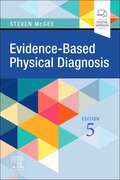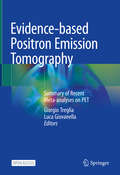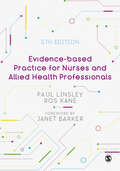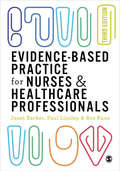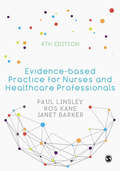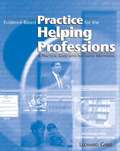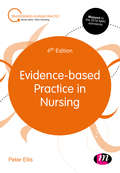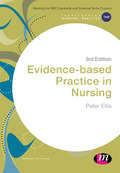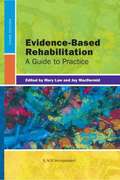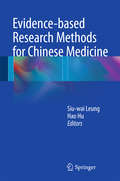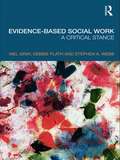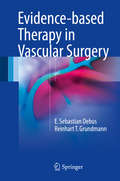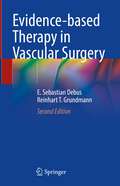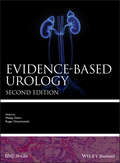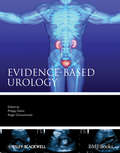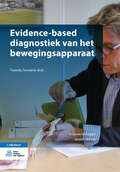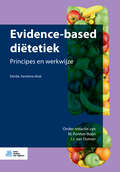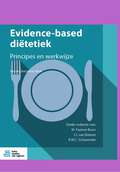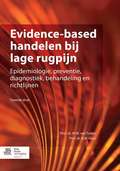- Table View
- List View
Evidence-based Physical Diagnosis
by Steven McGeeEvidence-based insights into physical signs have evolved and progressed greatly over the past few years, further defining how physical findings identify disease, solve clinical problems, and forecast patient outcomes. Evidence-Based Physical Diagnosis, 5th Edition, is an up-to-date, authoritative resource for guidance on interpreting physical signs, enabling you to determine the most appropriate physical finding to confirm a diagnosis. Incorporating more than 200 new studies, this definitive text helps you glean the most from what you hear, see, and feel at the bedside―information that, combined with modern technologic testing, will grant clinicians the keys to outstanding patient care. Emphasizes the most important physical signs needed to determine the underlying condition or disease. Internationally renowned author Dr. Steven McGee shows readers how to pare down the multiple tests needed to confirm a diagnosis, saving both the physician and patient time and money. Features a reader-friendly outline format, including dozens of "EBM boxes" and accompanying "EBM ruler" illustrations. Contains thorough updates from cover to cover, including new evidence on the scientific value of the Romberg test (spinal stenosis); oximeter paradoxus (cardiac tamponade); platypnea (liver disease); pupil size in red eye (acute glaucoma); hum test (hearing loss); and many more. Begins each chapter with a list of Key Teaching Points, intended for readers desiring quick summaries and for teachers constructing concise bedside lessons. Features a unique evidence-based calculator online that enables you to easily determine probability using likelihood ratios. Enhanced eBook version included with purchase, which allows you to access all of the text, figures, and references from the book on a variety of devices.
Evidence-based Positron Emission Tomography: Summary of Recent Meta-analyses on PET
by Luca Giovanella Giorgio TregliaThis open access book summarizes the findings of recent evidence-based articles (meta-analyses) on the use of positron emission tomography (PET) for various clinical indications. It is divided into five main sections, starting with an introduction to PET and meta-analysis. In turn, the second part addresses evidence-based PET in oncology, providing a broad overview of its use for different types of tumours. The remaining sections are focused on the use of PET in cardiology, in infectious and inflammatory diseases, and in neurology, respectively. Given its scope and the wealth of information it provides, the book will be an invaluable tool for clinicians with various specialties, as well as international scientific societies interested to the recent evidence-based data about PET.
Evidence-based Practice for Nurses and Allied Health Professionals
by Ros Kane Paul LinsleyThis long-standing textbook provides a clear overview of evidence-based practice. It explores the basic prinicples of knowledge, evidence and decision making and guides students through the process of crtitquing and using evidence in their day-to-day practice. The 5th edition has been updated to reflect contemporary approaches, drawing from lessons learned during the Covid-19 pandemic and includes a new chapter explaining the difference between evaluation, audit and research. Additional features: case studies, activities and end of chapter crossword puzzles help students consolidate their understanding provides a collection of practical appraisal tools and templates to use when reviewing differnet sources of research extensive glossary providing clear definitions of key terminology
Evidence-based Practice for Nurses and Allied Health Professionals
by Ros Kane Paul LinsleyThis long-standing textbook provides a clear overview of evidence-based practice. It explores the basic prinicples of knowledge, evidence and decision making and guides students through the process of crtitquing and using evidence in their day-to-day practice. The 5th edition has been updated to reflect contemporary approaches, drawing from lessons learned during the Covid-19 pandemic and includes a new chapter explaining the difference between evaluation, audit and research. Additional features: case studies, activities and end of chapter crossword puzzles help students consolidate their understanding provides a collection of practical appraisal tools and templates to use when reviewing differnet sources of research extensive glossary providing clear definitions of key terminology
Evidence-based Practice for Nurses and Healthcare Professionals
by Ros Kane Janet H Barker Paul LinsleyIn the current healthcare climate, it is more important than ever to be able to select and find the right evidence for your practice to ensure patients receive safe, high quality care. The fully updated new edition of this comprehensive book helps nurses and healthcare professionals understand how to use evidence in all aspects of care, with plenty of examples and activities to help relate concepts to practice. The new edition features: * Explanation of what values-based practice means and how it fits alongside evidence-based practice * A new chapter on innovation and improvement to help you make a difference in your practice * Even more examples from a range of professions to understand how different professions work together * Learning features to make it easier to learn, including word puzzles, chapter summaries and a glossary It is essential reading for all pre-qualifying and qualified nursing and allied health students who are exploring evidence-based practice for the first time. Janet Barker was formerly Associate Professor of Nursing at the University of Nottingham. Paul Linsley and Ros Kane are both Principal Lecturers at the University of Lincoln.
Evidence-based Practice for Nurses and Healthcare Professionals
by Ros Kane Janet H Barker Paul LinsleyIn the current healthcare climate, it is more important than ever to be able to select and find the right evidence for your practice to ensure patients receive safe, high quality care. The fully updated new edition of this comprehensive book helps nurses and healthcare professionals understand how to use evidence in all aspects of care, with plenty of examples and activities to help relate concepts to practice. The new edition features: * Explanation of what values-based practice means and how it fits alongside evidence-based practice * A new chapter on innovation and improvement to help you make a difference in your practice * Even more examples from a range of professions to understand how different professions work together * Learning features to make it easier to learn, including word puzzles, chapter summaries and a glossary It is essential reading for all pre-qualifying and qualified nursing and allied health students who are exploring evidence-based practice for the first time. Janet Barker was formerly Associate Professor of Nursing at the University of Nottingham. Paul Linsley and Ros Kane are both Principal Lecturers at the University of Lincoln.
Evidence-based Practice for Nurses and Healthcare Professionals
by Ros Kane Janet H Barker Paul LinsleyIn Evidence-based Practice for Nurses and Healthcare, the authors use case studies, examples, and theoretical overviews to guide readers through the concept of evidence-based practice and provides practical guidance on its utilisation in clinical practice. The new 4th edition has been fully updated to reflect contemporary practice, and includes a new chapter on the ‘History and Development of Clinical Academics,’ which looks at clinical academic careers and the impact and benefits this has for nurses and healthcare professionals on their clinical practice. Written to support nurses at pre and post-registration, the book includes an interdisciplinary focus covering health and social care curricula.
Evidence-based Practice for Nurses and Healthcare Professionals
by Ros Kane Janet H Barker Paul LinsleyIn Evidence-based Practice for Nurses and Healthcare, the authors use case studies, examples, and theoretical overviews to guide readers through the concept of evidence-based practice and provides practical guidance on its utilisation in clinical practice. The new 4th edition has been fully updated to reflect contemporary practice, and includes a new chapter on the ‘History and Development of Clinical Academics,’ which looks at clinical academic careers and the impact and benefits this has for nurses and healthcare professionals on their clinical practice. Written to support nurses at pre and post-registration, the book includes an interdisciplinary focus covering health and social care curricula.
Evidence-based Practice for the Helping Professions: A Practical Guide with Integrated Multimedia
by Leonard E. GibbsPractitioners in the helping professions make life-affecting judgments and decisions. This new integrated learning package seeks to improve practice reasoning through principles of logical thinking and evidence-based practice.
Evidence-based Practice in Nursing (Transforming Nursing Practice Series)
by Peter EllisDo your students feel unsure about what exactly constitutes evidence? Would you like them to feel more confident in evaluating evidence and applying it to their practice? Delivering safe, high-quality, patient-centred care is dependent upon nurses having a good understanding of evidence-based practice, and how to apply this successfully. However, for many students engaging with this side of practice is a challenge. This book has been specifically designed to help guide students through the process of identifying, evaluating and applying evidence in nursing practice. Using a variety of learning features, this text will help your students to see how the theory applies to their everyday practice and help them develop the skills they need to confidently use evidence in their clinical decision-making.
Evidence-based Practice in Nursing (Transforming Nursing Practice Series)
by Peter EllisDo your students feel unsure about what exactly constitutes evidence? Would you like them to feel more confident in evaluating evidence and applying it to their practice? Delivering safe, high-quality, patient-centred care is dependent upon nurses having a good understanding of evidence-based practice, and how to apply this successfully. However, for many students engaging with this side of practice is a challenge. This book has been specifically designed to help guide students through the process of identifying, evaluating and applying evidence in nursing practice. Using a variety of learning features, this text will help your students to see how the theory applies to their everyday practice and help them develop the skills they need to confidently use evidence in their clinical decision-making.
Evidence-based Practice in Nursing (Transforming Nursing Practice Series)
by Peter EllisEvidence-based practice is central to safe, high-quality and effective nursing. However, learning how to critique evidence and apply it to practice can be challenging at first. Written in clear, student-friendly language, this book builds your understanding of the terminology, theory and practice of using evidence. Learn how to evaluate different sources of evidence, apply this to your clinical decision making and, ultimately, contribute to an evidence-based culture in your workplace. Key features o Each chapter is mapped to the new 2018 NMC standards, showing how what you have learned relates to the requirements of a registered nurse o Filled with activities and student case studies to help you understand how to identify, evaluate and implement evidence-based practice o Promotes an evidence-based culture in all aspects of nursing practice, supporting your professional identity and development
Evidence-based Practice in Nursing (Transforming Nursing Practice Series)
by Peter EllisEvidence-based practice is central to safe, high-quality and effective nursing. However, learning how to critique evidence and apply it to practice can be challenging at first. Written in clear, student-friendly language, this book builds your understanding of the terminology, theory and practice of using evidence. Learn how to evaluate different sources of evidence, apply this to your clinical decision making and, ultimately, contribute to an evidence-based culture in your workplace. Key features o Each chapter is mapped to the new 2018 NMC standards, showing how what you have learned relates to the requirements of a registered nurse o Filled with activities and student case studies to help you understand how to identify, evaluate and implement evidence-based practice o Promotes an evidence-based culture in all aspects of nursing practice, supporting your professional identity and development
Evidence-based Practice in Nursing (Transforming Nursing Practice)
by Peter EllisThe need for an evidence base for nursing practice is widely accepted. However, what evidence is and how nurses might appraise and apply it to their practice is still a matter of some debate, which can leave the novice nurse feeling confused. This book uses clear language to help the reader develop skills in the identification, appraisal and application of evidence for nursing practice. It guides the reader in the development of underpinning skills such as reflection, critical thinking and research which allow the nurse to make sense of all the different forms of information and evidence that influence practice.
Evidence-based Rehabilitation: A Guide To Practice (Third Edition)
by Mary Law Joy MacDermidWhile evidence-based practice (EBP) has greatly influenced rehabilitation in the past decade, it continues to evolve and practitioners need guidance to implement evidence into their practice. Evidence-Based Rehabilitation: A Guide to Practice, the best-selling text providing step-by-step EBP guidance for rehabilitation professionals, has been updated into an expanded Third Edition. <p><p> In Evidence-Based Rehabilitation, Third Edition Drs. Mary Law and Joy MacDermid, along with their contributors, explain evidence-based rehabilitation, the concepts underlying EBP, and build the reader's knowledge and skills through specific learning. The text is organized by the steps of the EBP process--introduction to EBP, finding the evidence, assessing the evidence, and using the evidence. <p> EBP focuses first and foremost on making the best decisions for each client and using the best information available. For many rehabilitation practitioners, building skills in EBP is best done one step at a time. Evidence-Based Rehabilitation helps the rehabilitation student and practitioner develop his or her knowledge and skills to implement evidence-based rehabilitation in practice.
Evidence-based Research Methods for Chinese Medicine
by Siu-Wai Leung Hao HuThis book is a practical guide to the evidence-based medicine (EBM) research methods that are applicable to Chinese medicine (CM). It includes 3 parts: clinical research, healthcare data research and laboratory research. In each chapter, it explains how to acquire, analyze and evaluate a specific kind of CM research result. Authors exemplify the most important methods with successful cases in transforming reliable data into new knowledge of CM. This book emphasizes the requirements for CM researchers to design and conduct CM studies by following the best available principles, standards and guidelines.
Evidence-based Social Work: A Critical Stance
by Stephen Webb Mel Gray Debbie PlathEvidence-based practice is now a core element of many governments’ approaches to policy-making and social intervention. It has become a powerful movement that promises to change the content and structure of social work and its allied professions. Its emergence has generated much debate and raised challenging questions, however, particularly at the interface of research, policy, and practice. This book provides a critical analysis of evidence-based practice in social work. It introduces readers to the fast changing research, policy, legislative, and practice context. It discusses what constitutes knowledge in social work, the values and beliefs that lie behind EBP and problems of implementation, formalisation and resource management. Reflecting on the challenges of transferring evidence-based practice to frontline social work practice, the authors argue that social work practice is not easily measured and systematised into best practice guidelines that disseminate proven diagnostic and effective intervention knowledge. Using Actor Network Theory for the first time in the social work literature, Evidence-based Social Work illuminates how adopting the methodology and language of evidence-based practice fundamentally alters the conditions under which social work takes place. This book is vital reading for academics, practitioners, and students with an interest in contemporary social work practice and research.
Evidence-based Therapy in Vascular Surgery
by E. Sebastian Debus Reinhart T. GrundmannThis book is an introduction to quality initiative for vascular surgery and medicine. Originally published in German, the book is written by leading experts who utilise their professional expertise and insight to help raise the level of patient safety, quality of care, and training of junior vascular physicians. This books aims to bring together the best available current treatment and information, including recent guidelines, meta-analyses, and randomised trials to help put evidence-based therapeutic recommendations into practice. Innovative therapeutic treatment options are not currently incorporated within standard procedure, and this book will help physicians include these methods and create more individualised treatment.
Evidence-based Therapy in Vascular Surgery
by E. Sebastian Debus Reinhart T. GrundmannThis book is an introduction to quality initiative for vascular surgery and medicine. It will help to introduce the best available treatment options into clinical practice. For the 21 major vascular surgical diseases, this book enables targeted evidence-based treatment choice. Basics are the most recent published treatment results of open surgery and endovascular procedures. - What do international guidelines recommend?- Which treatment results have been published in recent Cochrane reviews, structured and systematic reviews, and meta-analyses? How are they to be interpreted?- Which new randomized trials exist?- What are the results in international registries?- How do the results in centres differ from those in medium and low volume hospitals? Analysis of the data leads to well-justified differentiated treatment recommendations that can be applied directly in hospitals, clinics and practices. The book will help to raise the level of patient safety, quality of care and training of junior vascular physicians.
Evidence-based Urology (Evidence-Based Medicine #59)
by Philipp Dahm Roger R. DmochowskiThis unique book provides up-to-date information on the appropriateness of both medical and surgical treatment options for a broad spectrum of urological conditions based on the current best evidence. Written by an international team of authors that stand out through their specialty expertise and leadership in practicing evidence-based urology, this book provides practical recommendations for the care of individual patients. Each chapter addresses a series of focused clinical questions that are addressed in a systematic fashion, including a comprehensive literature search, a rating of the quality of evidence, and an assessment of ratio of benefit and harm of a given treatment option. Evidence-Based Urology is an invaluable source of evidence-based information distilled into guidance for clinical practice.
Evidence-based diagnostiek van het bewegingsapparaat
by Arianne Verhagen Jeroen AlessieValide diagnostiek vormt de grondslag van adequaat (para)medisch handelen. Dit boek geeft een overzicht van de wetenschappelijke onderbouwing van de anamnese, het lichamelijke onderzoek, specifieke testen en beeldvormend onderzoek bij patiënten met klachten aan het bewegingsapparaat.Deze 2e druk is volledig geactualiseerd. Bij het boek hoort een website met video’s van valide diagnostische handelingen met bijbehorende psychometrische gegevens. Verscheidene vormen van klinisch redeneren passeren in een korte introductie de revue, gevolgd door hoofdstukken over de begrippen ‘validiteit’ en ‘reproduceerbaarheid’ en de verschillen tussen een enkele test vergeleken met die van gecombineerde testen. Diverse hoofdstukken behandelen vervolgens de diagnostiek van patiënten met lage rugpijn, pijn aan de heup, knie, de voet, nek en schouder, elleboog en hand en pols. Elk hoofdstuk begint met een casus en sluit af met een terugblik daarop. Tevens wordt aandacht besteed aan de alarmsignalen (‘rode vlaggen’) die op ernstige pathologie kunnen wijzen.Evidence based diagnostiek van het bewegingsapparaat biedt een schat aan informatie voor huisartsen, fysiotherapeuten, studenten en overige professionals die belang hebben bij een actuele wetenschappelijke onderbouwing van de diagnostiek van klachten van het bewegingsapparaat.Arianne P. Verhagen is fysiotherapeut, manueel therapeut en klinisch epidemioloog. Zij is in 1999 gepromoveerd en vanaf juli 1999 tot januari 2018 werkzaam geweest als senior onderzoeker en projectleider bij de afdeling Huisartsgeneeskunde van het Erasmus MC. Van 2009 - 2014 lector ‘Diagnostiek’ aan de opleiding fysiotherapie van de Avans Hogeschool in Breda en deze functie is de aanleiding geweest voor dit boek. Vanaf 1 februari is Arianne hoofd opleiding en hoogleraar onderzoek aan de opleiding fysiotherapie van de UTS (University of Technology Sydney) in Australië. Jeroen Alessie is fysiotherapeut, educational science & technologist en als hogeschooldocent verbonden aan de opleiding fysiotherapie van de Avans Hogeschool in Breda.
Evidence-based diëtetiek: Principes en werkwijze
by M. Former-Boon J.J. van DuinenDit boek biedt voedingskundigen en diëtisten handvatten om met de best bewezen zorg, de beste zorg op maat te bieden. Het laat zien hoe wetenschappelijk onderzoek gecombineerd wordt met de ervaring van de diëtist, de wensen van de cliënt en andere informatiebronnen, zoals het internet.
Evidence-based diëtetiek: Principes en werkwijze
by M. Former-Boon J.J. van Duinen R.W.C. SchuurmanDit boek beschrijft een gestructureerde aanpak om te komen tot optimale voedingszorg. Het is bedoeld voor diëtisten in de eerste- en tweedelijnszorg én voor studenten. Het boek draagt bij aan de professionalisering van de diëtetiek in Nederland en Vlaanderen.Evidence-based diëtetiek is een belangrijk onderdeel van het diëtistisch zorgproces. Het is een transparante beroepsuitoefening waarbij het verlenen van professionele voedingszorg gebaseerd is op informatie uit het beste wetenschappelijke onderzoek, de kennis en ervaringen van de diëtist en situatie, waarden en voorkeuren van de patiënt. Door deze gestructureerde aanpak komen diëtisten samen met de patiënt tot de best passende behandeling. Deze vierde druk van Evidence-based diëtetiek. Principes en werkwijze gaat in op de vijf stappen van evidence-based diëtetiek. Iedere stap is uitgewerkt in een apart hoofdstuk: het formuleren van een duidelijke vraag, het zoeken en vinden van wetenschappelijke bronnen, het beoordelen van de kwaliteit van bronnen, en het implementeren en het evalueren van de behandeling. Aan de hand van praktijkvoorbeelden illustreert het boek hoe professionals de vijf stappen kunnen toepassen. De auteurs hebben veel kennis en ervaring op het gebied van evidence-based diëtetiek. Ze werken als diëtist of zijn betrokken bij toonaangevende onderzoeken op voedingsgebied, werkzaam in academische ziekenhuizen en/of als docent.
Evidence-based handelen bij lage rugpijn: Epidemiologie, preventie, diagnostiek, behandeling en richtlijnen
by B. W. Koes M.W. van TulderIn 2006 verscheen de eerste druk van de uitgave "evidence based handelen bij lage rugpijn". Aanleiding daarvoor was het grote aantal richtlijnen dat in de jaren daarvoor ontwikkeld werd bij de verschillende behandelaars in de eerste lijn (aparte richtlijnen voor bedrijfsartsen, huisartsen, fysiotherapeuten, CBO richtlijnen) etc. Het boek richt zich vooral op de wetenschappelijke onderbouwing van de richtlijnen. Het onderbouwt medisch en paramedische richtlijnen.
